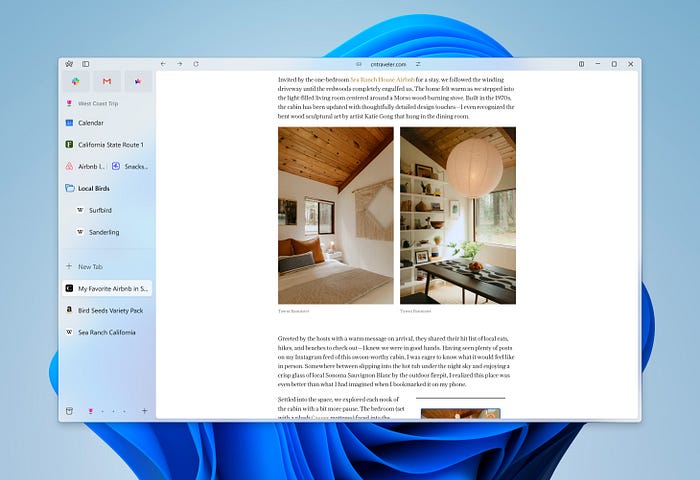Arc Browser Review: Navigating Innovation and Efficiency
 Jose Rodrídguez
Jose Rodrídguez
For a long time, I've found myself endlessly switching between different web browsers, each introducing a few new features. Some claimed to protect my privacy, others aimed to break my dependence on major tech entities, and a few allowed extensive customization. However, none of them addressed my primary concern: managing a multitude of open tabs.
The core issue with most browsers is their adherence to a traditional design that hasn't changed much over the years: a top-placed address bar, followed by bookmarks, with similar approaches to multitasking. Choosing an early 2000s browser like Netscape, navigation would feel familiar. But our internet usage has transformed significantly. Nowadays, our lives practically unfold in browsers, opening new tabs for everything from watching films, streaming music, to creating spreadsheets.
This led me to discover Arc Browser, a groundbreaking browser I've been committed to for the past year. What distinguishes Arc is noteworthy.
Why is there a demand for a novel browser experience?

Traditional web browsers like Google Chrome and Safari struggle to keep pace with contemporary online activities. Despite the addition of many features over time, their foundational design remains outdated and limiting. The management of multiple tabs, for instance, quickly becomes a hassle as tabs diminish to barely visible sizes after opening just a few, making it difficult to locate a specific one. Even using features like tab groups doesn't alleviate the problem, as they add to the clutter on the already crowded tab bar.
I've also found that performing multiple tasks simultaneously is nearly impossible with conventional browsers, as my only option is to open numerous windows and depend on my device's ability to manage split screens. This solution falls short when handling many tabs rather than applications. And the challenges don't stop there.
Given that these browsers cater to hundreds of millions of users, it's unrealistic to expect significant changes from companies like Apple and Google in the near future. This is where Arc comes into play.
Arc positions itself as an "internet computer," reimagining many aspects of the traditional web browser. It aims to transform the browser into something resembling an operating system: featuring a search function akin to Spotlight, a dock for your most visited sites, a split-screen option for managing tabs, dedicated workspaces, among other innovations. It introduces bold concepts, such as automatically archiving tabs that haven't been accessed in 12 hours and removing the familiar omnibar at the top in favor of a left-sided dashboard. Although some of these features seemed strange initially, they've become integral to my web browsing experience, proving to be not just useful, but necessary.
My Journey to Adopting the Arc Browser
Arc fundamentally rethinks the design of web browsers by stripping away or completely redesigning traditional elements and controls. Everything is neatly organized into a sidebar, allowing the webpage content to dominate the screen. Initially, this new layout may seem daunting, but its utility becomes apparent the more you use it.
The design of Arc's interface is carefully considered, addressing numerous frustrations I've encountered with other browsers. Take the address bar --- it doesn't need to stretch across the screen, so Arc compactly places it in the upper-left corner. A single click reveals the full URL if needed.
In Chrome, my frequently visited sites like Gmail get pinned but remain in the tab row, often getting squeezed into obscurity. This forces me to reopen them in new tabs, cluttering my workspace with duplicates. Arc innovates here by pinning these favorites at the sidebar's top, similar to how a computer's taskbar or dock manages applications. This not only facilitates quick access but also allows me to glance at notifications for supported sites, like my inbox or calendar, without fully opening them.
Exploring Arc reveals a multitude of subtle yet impactful differences that collectively enhance the web browsing experience significantly.
Managing Tabs in Arc
Arc introduces a unique approach to tab management compared to the vertical listing seen in browsers like Microsoft Edge. Its sidebar is organized into three main areas:
The top section is dedicated to pinned favorites.
The middle portion houses your bookmarks.
The bottom section contains temporary tabs, which are automatically archived after the window is closed or if they remain unused for a period.
What truly distinguishes Arc, however, is its feature called "Spaces," mirroring the concept of workspaces on a desktop computer. Each Space can hold its own collection of pinned tabs and bookmarks, allowing users to organize different activities such as work-related tasks, vacation planning, and more into separate areas.
This departure from amalgamating all tabs into one mass has been a welcome change. I have previously relied on third-party extensions for workspace functionalities, so having this feature integrated into Arc was a significant improvement. Additionally, since Arc is built on the Chromium platform, it supports all Chrome extensions.
Switching between Spaces is effortlessly simple compared to managing multiple browser windows. Arc also offers a comprehensive view mode to overview all Spaces and tabs simultaneously. Despite its capability to handle a vast array of information, Arc's design remains uncluttered, striking an ideal balance between readability and functionality, unlike some browsers that overcrowd tabs and data.
Arc also aims to minimize unnecessary tab proliferation. For instance, clicking a link on Twitter doesn't open a new tab but previews it in a pop-up window, which can be closed with a click elsewhere. This feature has significantly reduced the number of tabs I need open, preventing the buildup of forgotten tabs that waste resources.
One drawback I've noted is the inability to open a new, blank window or Space; any new window automatically includes your favorites and bookmarks. This option existed in earlier versions of Arc but has since been removed. While the sidebar can be hidden, its presence can sometimes be a distraction when focusing is the priority.
Moreover, using the Ctrl / Command + T shortcut in Arc doesn't simply open a new tab. It prompts a search bar that directs you to an existing tab if the URL is already open in your workspace, or opens it in a new tab if not. While intentional, this feature may occasionally slow down workflow, depending on the user's habits.
Enhanced Multitasking with Arc
Arc significantly streamlines multitasking across multiple tabs. Its split-view feature is particularly useful, enabling me to work with up to four tabs simultaneously within the same window. A feature I find invaluable is the ability to treat a multi-tab view as a single tab, which can be saved, renamed, and relocated. This means I can quickly access a setup where Gmail and Google Docs are displayed side by side without having to arrange them again.
The browser's search functionality is a cornerstone for smooth multitasking in Arc, facilitating quick searches, executing keyboard shortcuts, and navigating between spaces effortlessly. However, it's worth mentioning that the search feature can occasionally exhibit delays or bugs, sometimes requiring a bit more time to display results.
Arc introduces several multitasking features that have become indispensable to me:
It conveniently displays media controls, such as pause and play, for active media content.
Quick access to recent downloads is available by hovering over the bottom-left corner, allowing for easy drag-and-drop interactions with websites.
Video feeds automatically pop out into their own window when I navigate to a different tab, ensuring I don't miss any content.
These functionalities greatly enhance the browsing experience by making multitasking more intuitive and efficient.
Design Philosophy of Arc
Arc positions itself as a sophisticated tool for power users, yet its design ensures that the interface remains user-friendly and approachable. The browser's minimalist aesthetic, paired with the strategic application of subtle color schemes, helps maintain a clean and organized appearance, even when juggling numerous tabs and vast amounts of information.
Moreover, Arc offers a high degree of customization, allowing users to select distinctive color palettes for different workspaces, further enhancing the visual differentiation and personalization of the browsing experience. This level of customization extends across the interface, affecting how various elements and sections are displayed.
Compared to other browsers, Arc's design aesthetic stands out for its elegance and freshness. Even after a year of use, its visual appeal hasn't diminished, continuing to offer a pleasing and engaging user experience.
Platform Compatibility Challenges with Arc
One significant limitation of Arc that I've encountered is its exclusivity to the Mac platform. This restriction poses a challenge for me, as it prevents the synchronization of my work across the diverse range of devices I use, such as my iPad and Windows PC. While the startup behind Arc, The Browser Company, has announced that a Windows version is on the horizon and will be available in beta shortly, the absence of a fully compatible version across all platforms remains a notable drawback.
However, there is a workaround for iOS users. The Browser Company offers an iOS companion app that facilitates some level of interaction with Arc on Mac. This app allows users to access their tabs and spaces from their Mac or to send links back to the Mac for later reading. Although this feature offers a partial solution, the lack of comprehensive cross-platform support currently limits Arc's usability for those who rely on multiple devices for their workflow.
Whether to Switch to Arc: A Consideration
Arc has become an integral part of my daily workflow, fitting in as though it was tailor-made for my needs. However, it's crucial to acknowledge that Arc isn't universally suited for everyone. Transitioning to Arc requires getting acquainted with numerous novel concepts and functionalities. For those whose daily activities don't heavily revolve around browser use, the learning curve associated with Arc may not offer sufficient value to warrant the switch.
On the flip side, for individuals grappling with the incessant challenge of managing excessive tabs and seeking relief from the constraints imposed by traditional browsers, the decision to adopt Arc could be remarkably straightforward. Arc's innovative features designed to enhance tab management, workspace customization, and overall browser efficiency present a compelling solution to common browsing woes. If you're in a constant struggle with tab clutter and inefficiency, switching to Arc could represent a significant improvement to your browsing experience and productivity.
Ready to take your workflows to the next level? Explore a vast array of workflow automation apps and tools, along with their alternatives, at Productivity Directory and Read more about them on The Productivity Blog. Find the perfect fit for your workflow needs today!
Subscribe to my newsletter
Read articles from Jose Rodrídguez directly inside your inbox. Subscribe to the newsletter, and don't miss out.
Written by
